Posted by: Northwest Eye in General on June 28, 2025
Overview
This article offers essential insights into the different types of eye floaters and their implications for your eye health. We understand that noticing floaters can be concerning, and it’s important to recognize their characteristics, potential risks, and treatment options.
While many floaters are harmless, it’s crucial to be aware that some may indicate serious conditions that require medical attention. We are here to help you through this process and ensure you feel supported in addressing your eye health concerns.
Introduction
Understanding eye floaters is crucial for maintaining optimal vision and overall eye health, especially as we age. We recognize that age-related changes can be concerning, and it’s common to feel anxious about these visual disturbances.
With nearly half of individuals experiencing floaters by age 50, it’s important to acknowledge the significance of recognizing their types and implications. This article delves into essential insights about various floater types, their impact on vision, and effective management strategies.
We are here to help you navigate the complexities of these visual disturbances and ensure your eye health remains a priority.
Northwest Eye: Expert Care for Eye Floaters
For more than 50 years, Northwest Eye has been a trusted provider of vision services in Minnetonka, Minnesota, particularly focusing on concerns such as floaters in the eye. We understand that dealing with vision issues can be challenging, which is why our dedicated team of skilled eye surgeons, including specialists in cataract and refractive procedures, is committed to offering personalized care tailored to your unique needs. Research shows that nearly 50% of individuals experience floaters in the vitreous by age 50, a figure that rises to 65% by age 65. This highlights the importance of effective management strategies to address these common concerns.
At Northwest Eye, we prioritize your education by providing resources that help you understand your condition and treatment options. encompass a range of conditions, including:
This ensures that you receive expert care designed specifically for you. Many of our patients share their experiences, emphasizing our compassionate approach and the effectiveness of our treatments, which have significantly improved their quality of life. For instance, patients have reported that effective management of floaters in the eye has minimized visual disturbances that once interfered with their daily activities.
Located at the Minnetonka Surgery Center, we are at the forefront of the latest advancements in eye health for visual disturbances. We utilize cutting-edge technology and innovative treatment options, including ongoing research into non-invasive techniques and imaging devices that enhance diagnostic accuracy and treatment effectiveness. Furthermore, Northwest Eye offers a variety of financing programs and payment plans to make the cost of care manageable and accessible.
By fostering an environment of learning and support, we ensure that you are well-informed about your condition, including the significance of visual disturbances and their potential impact on your overall eye health. This holistic approach not only addresses immediate concerns but also encourages long-term eye wellness, reassuring you that we are here to help you through this process.
Diffuse Floaters: Characteristics and Implications
Diffuse spots can appear as small, cloud-like floaters in your field of vision. We understand that noticing these changes can be concerning. Often, they are caused by age-related changes in the vitreous humor, the gel-like substance in your eye. While diffuse spots are usually harmless, it’s important to recognize that their presence as a floater may signify that could need monitoring.
Being aware of these characteristics can empower you to better understand your eye health. If you notice these spots, it’s perfectly normal to feel uncertain about what it means. We encourage you to seek further evaluation if you have any concerns. Remember, we are here to help you through this process, ensuring you receive the care and support you need.
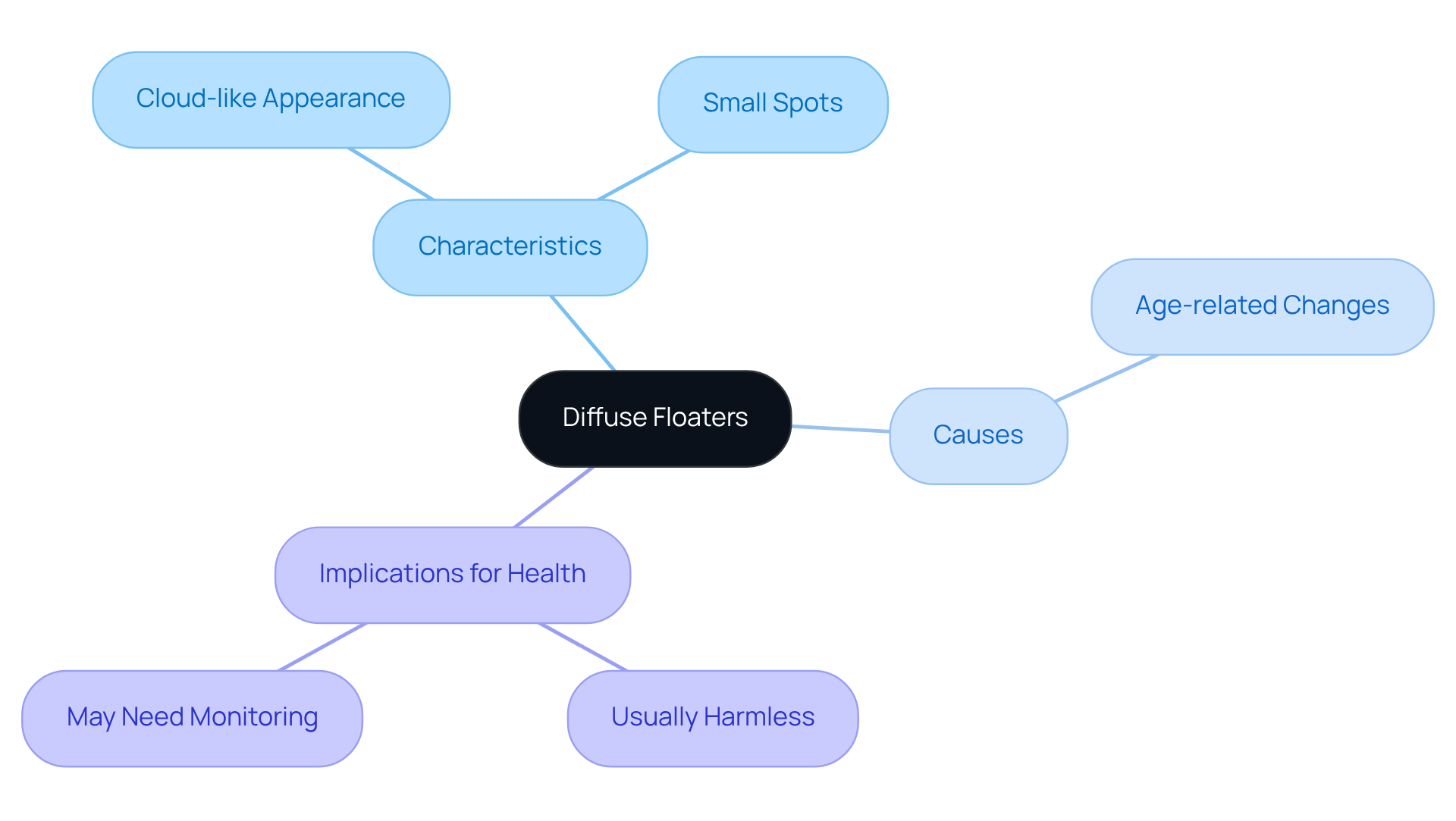
Fibrous Strand Floaters (Cobweb Floaters): Visual Disturbances Explained
Fibrous strand artifacts, often called cobwebs, can be quite disconcerting. These thin, thread-like strands drift across your field of vision, and they usually result from the aggregation of collagen fibers in the vitreous, the gel-like substance in your eye. While they may be bothersome, it’s comforting to know that cobwebs are . However, many patients express significant visual disruptions, sharing how these spots can make it difficult to concentrate, especially in bright light or against simple backgrounds. We understand that this can lead to frustration and distraction during daily activities like reading or driving.
Recent findings indicate that as the vitreous matures, collagen fibers may cluster more frequently, increasing the likelihood of vision disturbances. If you’re experiencing new visual disturbances, particularly if they come with flashes of light or an increase in their number, it’s important to seek prompt consultation with an eye care professional. These symptoms could signal more serious conditions, such as retinal tears or detachment, which require immediate attention to prevent potential vision loss. In fact, statistics reveal that 1 in 6 individuals may experience a retinal tear due to posterior vitreous detachment. Recognizing warning signs, such as new spots and flashes of light, is crucial.
Understanding the characteristics of cobweb distortions and their impact on your vision, including the presence of floaters, can empower you to take proactive steps in managing your eye health. Exciting advancements, like the use of vapor nanobubbles created by gold nanoparticles to eliminate collagen aggregates responsible for visual disturbances, represent promising treatment options that may be available in the future. By staying informed and vigilant, you can navigate your eye health journey with confidence and support.
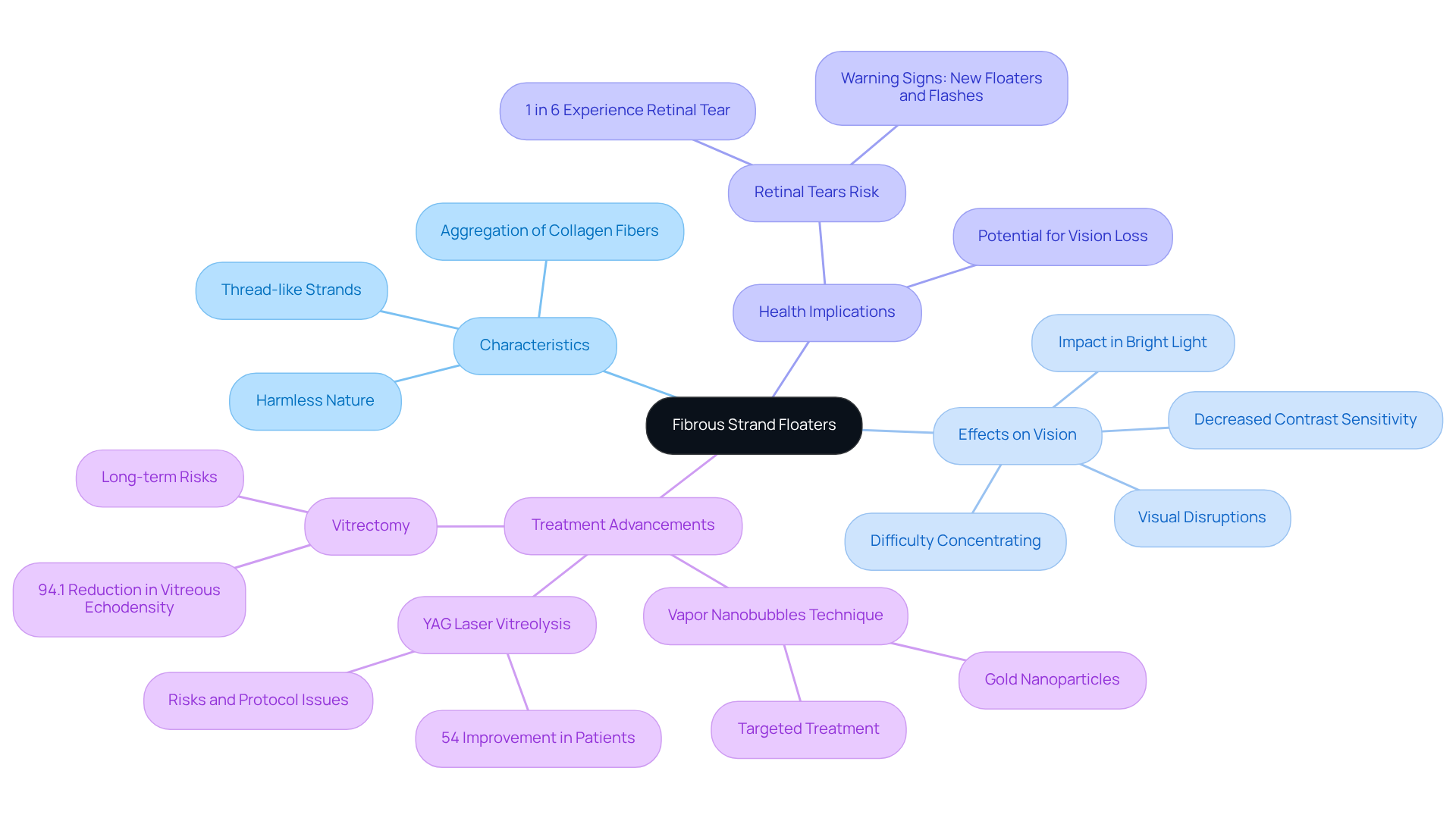
Weiss Ring Floaters: What They Indicate About Eye Health
We understand that noticing floaters, such as Weiss ring floaters, can be concerning. These larger, ring-shaped entities may indicate vitreous detachment, which happens when the vitreous gel pulls away from the retina. This process can create a shadow that appears as a ring in your field of vision. While it’s often a normal aspect of aging, we encourage you to observe these spots closely.
If you experience flashes of light or a sudden rise in visual disturbances alongside these floaters, it’s important to consult with an eye care provider without delay. This step is crucial to rule out any potential retinal issues. Understanding these symptoms can be vital, as they may also relate to other conditions, such as blurred vision, which can signal underlying eye diseases.
At Northwest Eye, we are here to help you through this process. We encourage you to seek professional medical help for any concerning symptoms to ensure proper diagnosis and treatment. Your vision is important, and we want to .
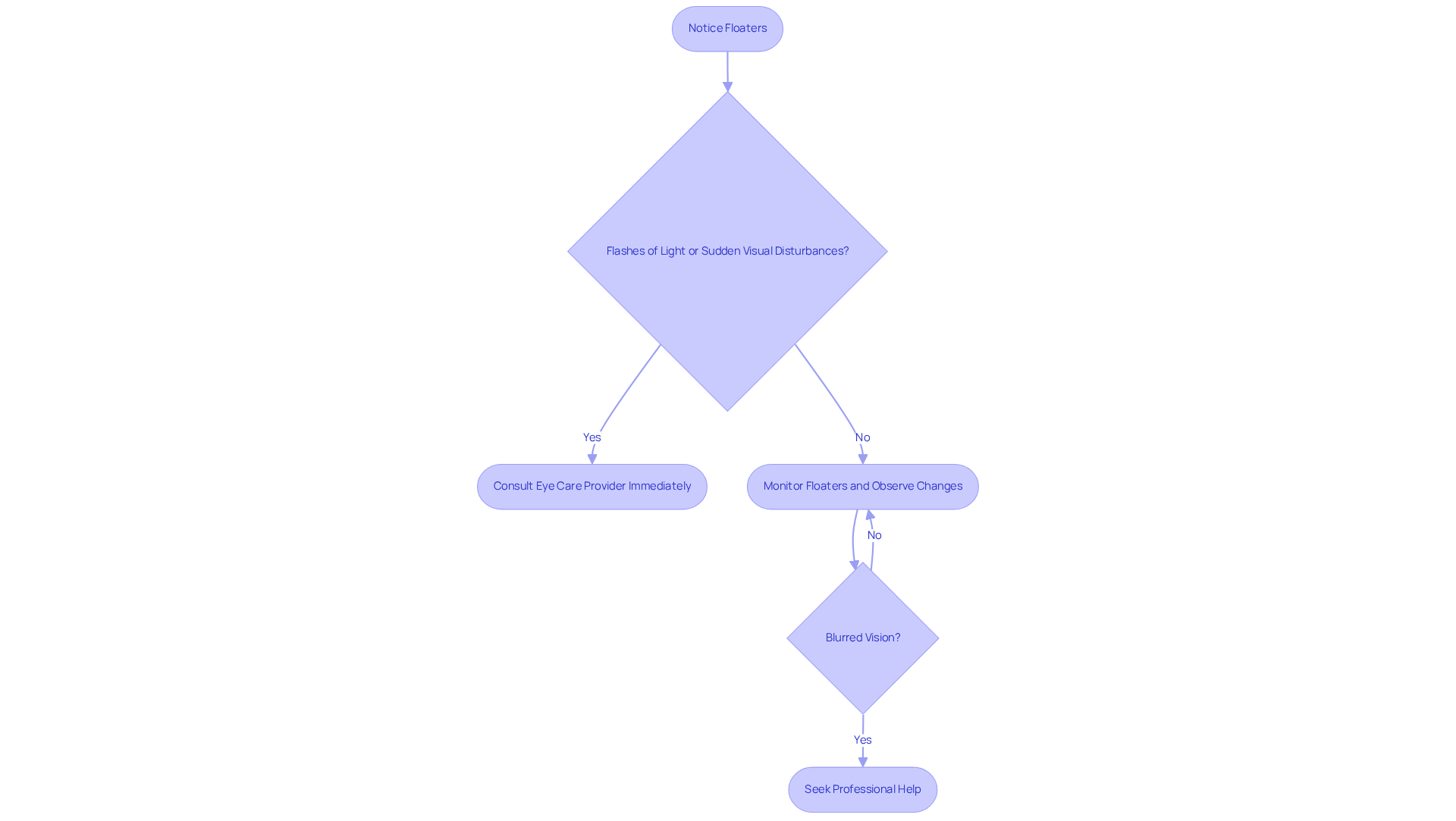
Color Variations in Eye Floaters: Understanding Their Significance
Eye spots can appear in a variety of colors, including black, gray, and transparent hues. We understand that noticing these changes can be concerning. The hue of a buoy is influenced by its composition and the lighting conditions under which it is observed. Darker spots typically indicate denser aggregates of vitreous material, while lighter or transparent ones may suggest less serious concerns. Recognizing these color variations is crucial for individuals, as sudden changes in visual disturbances, particularly in color, can signal serious issues such as retinal tears or detachment, which require prompt medical attention.
It’s common to feel anxious about visual disturbances, especially for those over 50 or individuals with conditions like myopia or diabetes. Studies show that these disturbances are more prevalent in these groups, underscoring the importance of being aware of your eye health. Understanding the composition and visibility of eye specks can empower you to take an active role in managing your eye health. We encourage you to schedule to monitor any visual disturbances and to discuss any changes with your eye care provider. Remember, you are not alone in this journey; we are here to help you through the process.
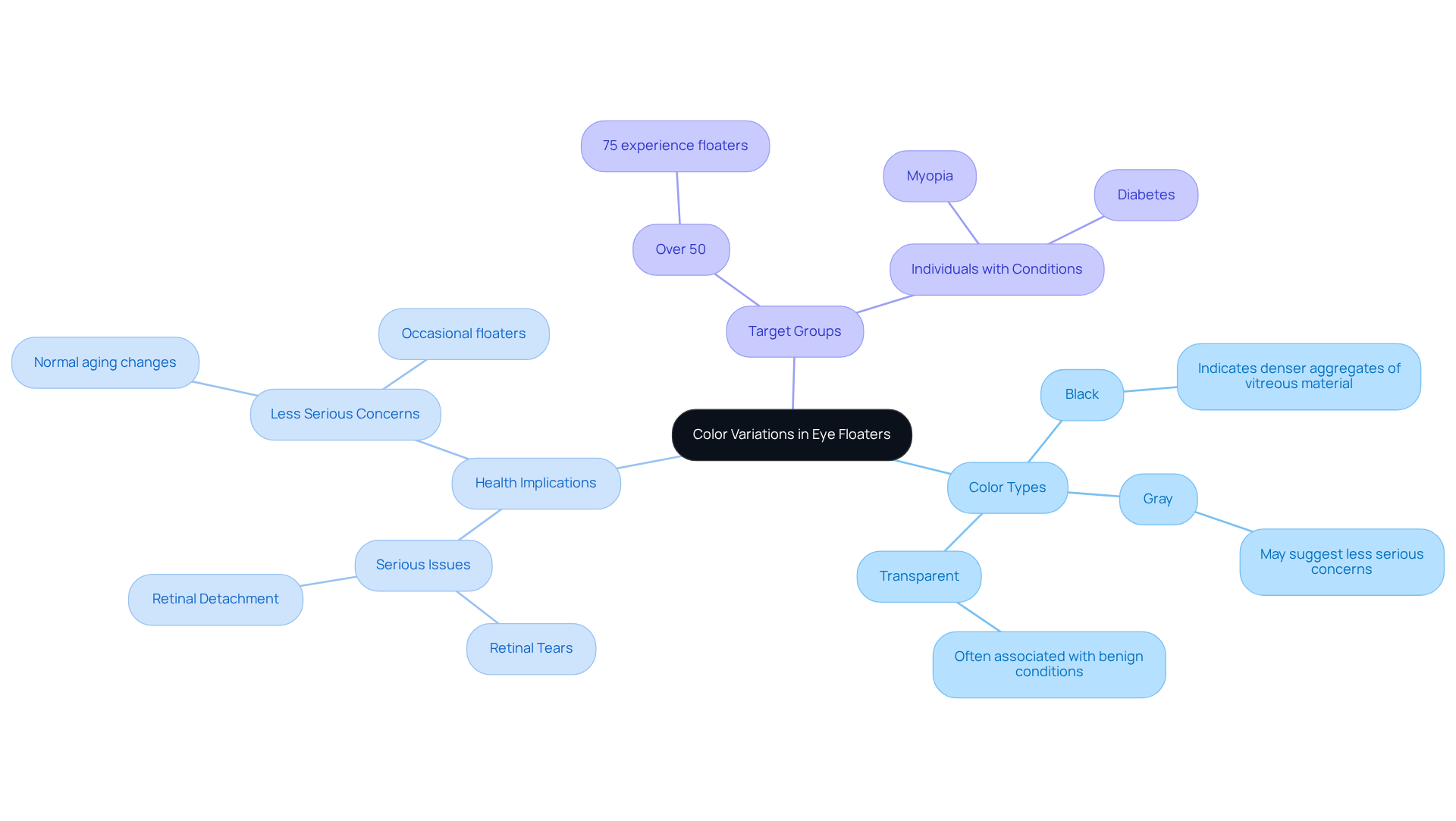
Floaters and Flashes: Recognizing the Connection
Floaters, which are a common eye condition, and flashes often occur together, and recognizing this connection is vital for your eye health. Flashes of light can indicate that the vitreous is pulling on the retina, which may lead to retinal tears or detachment. We understand that encountering floaters, as well as flashes, especially if they arise suddenly or increase in frequency, can be concerning. It is crucial to seek urgent medical assistance to avert possible vision loss.
Additionally, blurred vision can be a symptom of various eye conditions, including cataracts, diabetic retinopathy, dry eyes, and macular degeneration. This underscores the importance of a . As one individual expressed, “I just wanted to thank EyeCare America. My dad has glaucoma, and I’ve been very worried for some time that I might too, but could not afford to get checked out. I discovered that the dark spot I was observing was merely something referred to as a visual artifact. What a relief!” This highlights the emotional impact of understanding these symptoms.
A case study demonstrates how prompt intervention can ease worries: an individual who was initially anxious about a black spot found out it was a visual disturbance, resulting in tranquility. At Northwest Eye, individuals can access advanced cataract surgery and LASIK procedures. If you are experiencing any concerning symptoms, we are here to help you through this process. Schedule an appointment with a Northwest Eye doctor to ensure your eye health is prioritized.
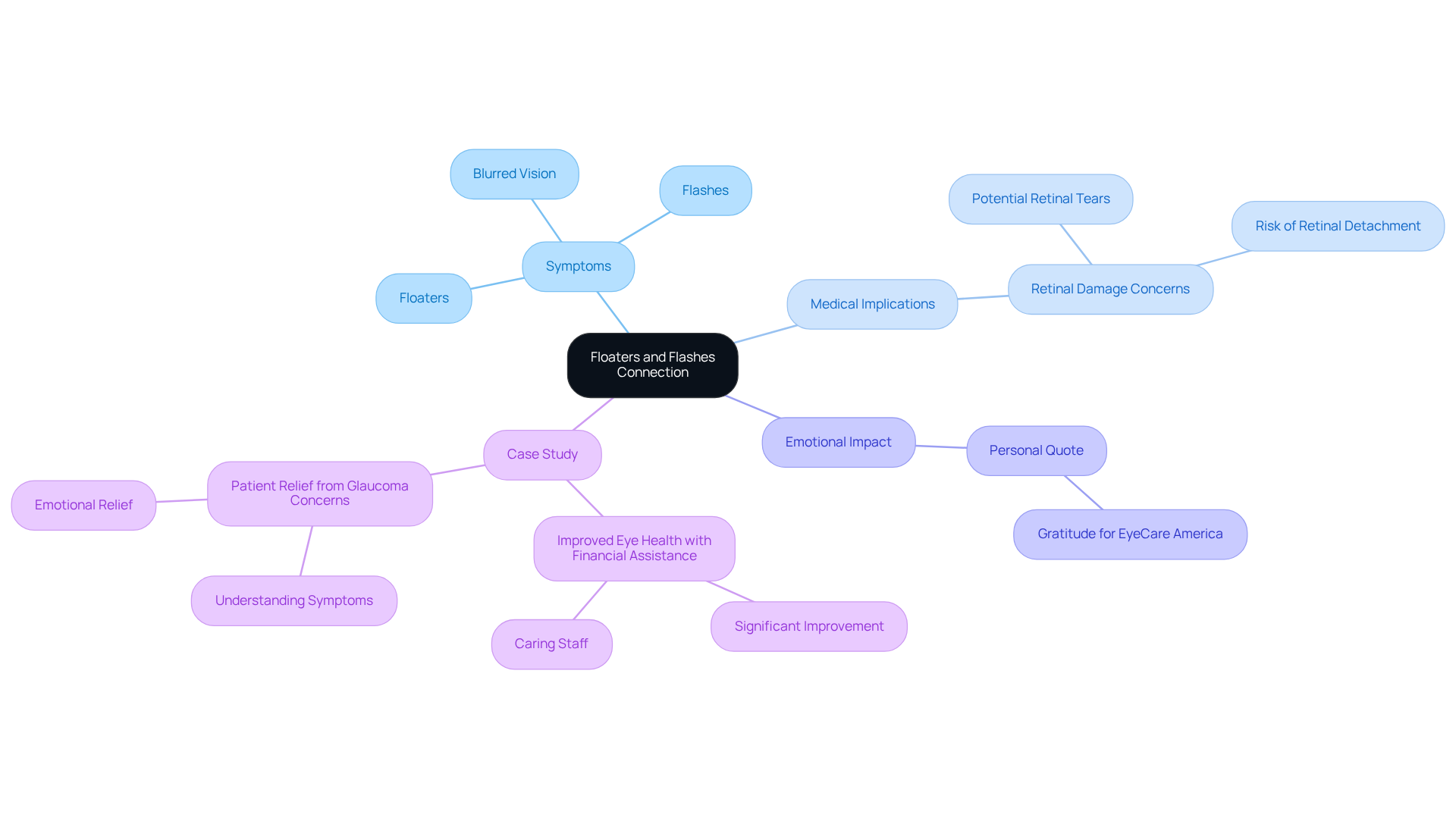
Importance of Eye Exams: Monitoring Floaters and Eye Health
Routine eye check-ups are essential for tracking visual disturbances and maintaining overall eye health. We understand that navigating eye health can be concerning, and at Northwest Eye, our doctors and eye care professionals prioritize not only the treatment of eye conditions but also ensuring that you feel informed about your eye health. These comprehensive assessments allow us to evaluate the condition of the vitreous and retina, facilitating the early detection of any changes that may arise.
Studies suggest that people who have regular eye check-ups see better results, especially in recognizing issues such as spots that might affect vision quality. It’s common to feel uncertain about when to schedule these exams, but we encourage you to do so, especially if you notice new floaters or changes in your vision. Timely intervention can significantly enhance your eye health and overall quality of life.
Through our Be Eye Wise initiative, we aim to empower you with knowledge about your eye health. We emphasize that consistent monitoring during these exams is crucial for recognizing potential issues before they escalate. This ensures that you receive the essential support and direction tailored to your unique needs.
Schedule an appointment today to take the first step towards .
- “Great place. The doctors and staff were exceptionally understanding with our very active 15-month-old daughter – Lydea L.”
- “All of the staff at Northwest Eye are friendly and get your needs taken care of in the best of ways. A visit to any of the clinics is a great experience.” – Perry H.
Psychological Impact of Eye Floaters: Addressing Patient Concerns
Living with a floater can understandably lead to feelings of anxiety and frustration for many patients. We recognize that the persistent presence of these floater spots can be distracting and may impact your daily activities. It’s important to discuss your concerns about the floater with your [eye care provider](https://nweyeclinic.com), who can offer reassurance and helpful coping strategies. Remember, floaters as visual disturbances are often harmless, and understanding this can significantly reduce some of the psychological burdens you may be experiencing.
We are here to help you through this process. By acknowledging your feelings and seeking guidance, you can find comfort and support. It’s common to feel overwhelmed, but you are not alone in this journey. Your eye care provider is a , ready to assist you in navigating these challenges.
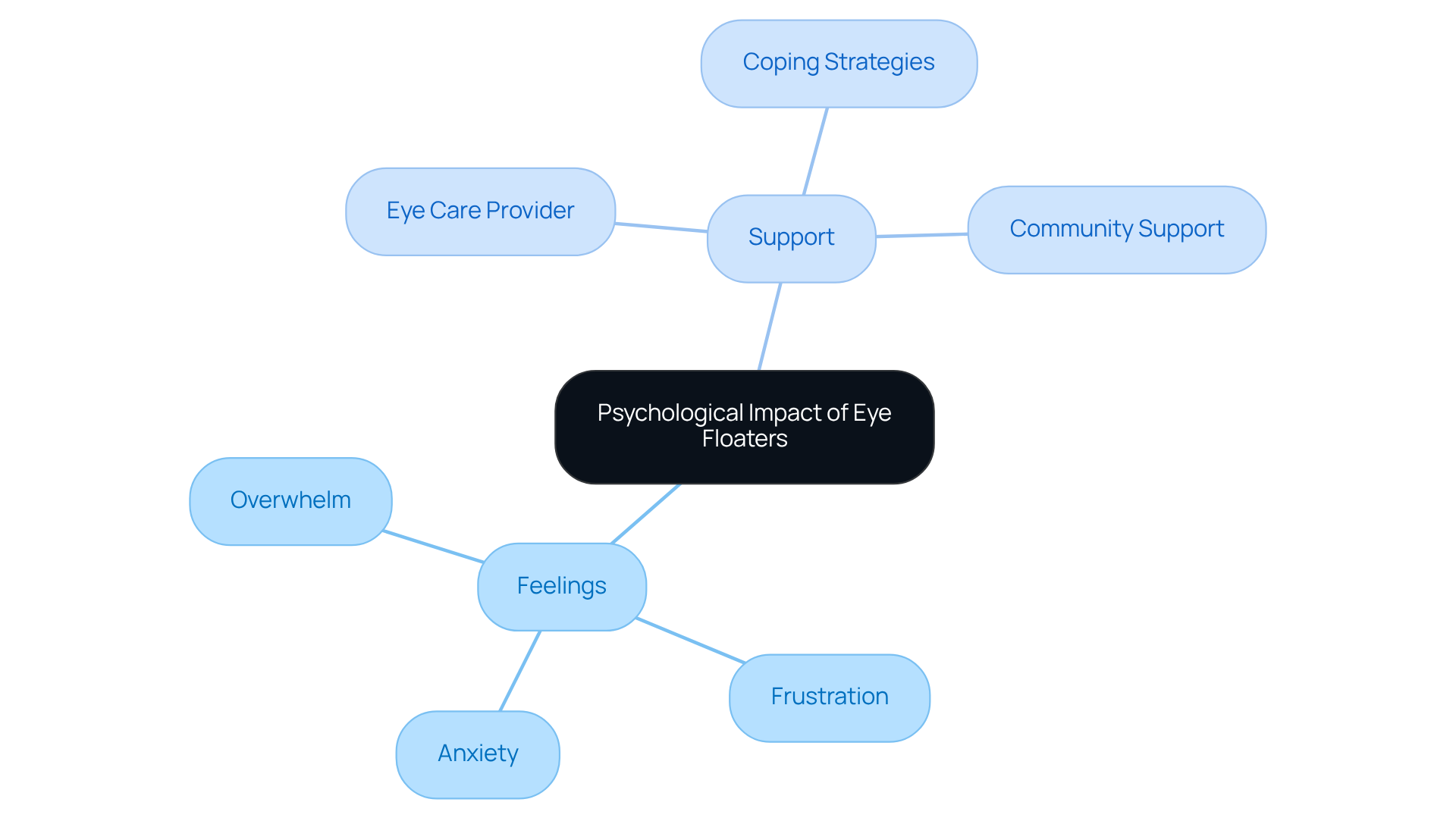
Treatment Options for Eye Floaters: What Patients Should Know
While most eye floaters are harmless and may lessen over time, we understand that they can occasionally disrupt your daily activities. If these specks, which may be floaters, considerably impede your vision or are accompanied by other concerning symptoms, it’s important to consider treatment options.
- Laser therapy, particularly YAG laser vitreolysis, has shown promising results in alleviating visual disturbances caused by floaters. Research suggests that around 70.59% of individuals reported significant or total improvement following treatment in a study involving 51 eyes.
For more severe cases involving a floater, vitrectomy—a surgical procedure that removes the vitreous gel—may be recommended. However, it’s essential to be aware that this procedure carries risks, including:
- Infection
- Bleeding
- Retinal tears
- The potential development of a floater
We encourage you to discuss your symptoms in detail with your eye health provider to identify the most suitable treatment plan tailored to your individual needs.
Recent advancements in laser therapy have made it a viable option for treating floater conditions. Yet, it is crucial to weigh the benefits against potential risks, such as from a floater. Observing visual disturbances, including a floater or flashes, is essential; if you notice a sudden increase in such disturbances, please reach out to your eye care professional promptly.
Proactive communication with an eye specialist is vital for ensuring optimal eye health and addressing any concerns regarding visual disturbances, such as a floater. Remember, we are here to help you through this process.

Lifestyle Changes to Manage Eye Floaters: Practical Tips
While we understand that eye disturbances may not be entirely preventable, adopting specific lifestyle changes can significantly reduce their impact. Maintaining proper hydration is essential; dehydration can worsen the visibility of spots. We recommend that men consume each day, while women should strive for 11.5 cups. A diet abundant in antioxidants—found in fruits and vegetables—promotes overall eye wellness and may help diminish visual disturbances.
It’s also crucial to shield your vision from UV rays, as excessive exposure can lead to various visual conditions. Furthermore, practicing eye exercises, such as rolling your eyes or changing focus, can assist in reducing the perception of visual disturbances. Regular eye exams are vital for monitoring eye health and addressing any changes promptly.
Many patients have shared positive testimonials about how these lifestyle adjustments have improved their overall eye comfort and health, reinforcing the importance of proactive care. For those seeking additional options to manage floaters, we want to highlight that innovative treatments like laser vitreolysis for floaters are available at Northwest Eye. We are here to help you through this process and ensure your eye health is a priority.
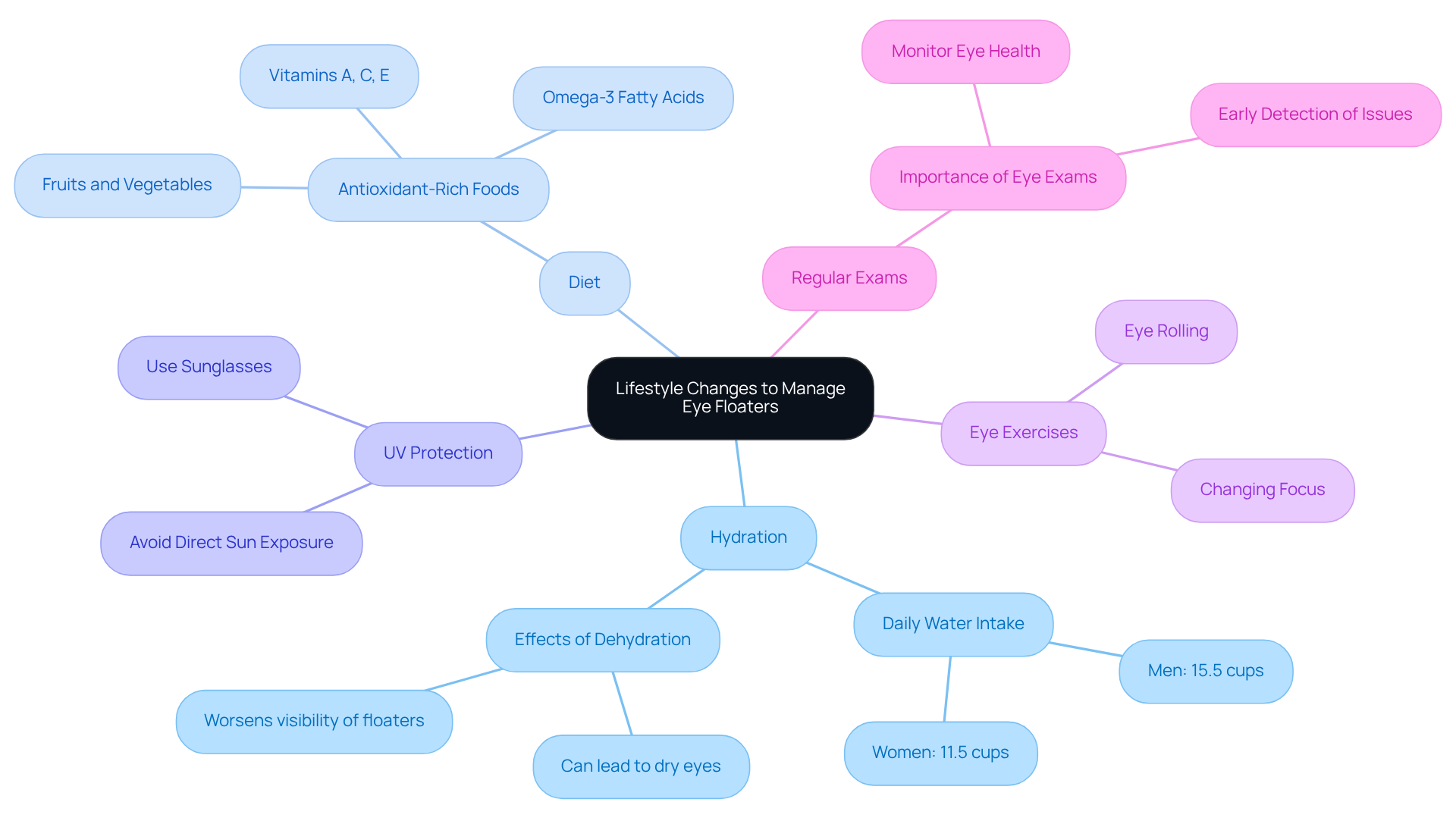
Conclusion
Understanding eye floaters is crucial for maintaining optimal eye health and addressing any concerns that may arise. We understand that experiencing floaters can be unsettling, but this article highlights the various types of floaters, their implications for vision, and the importance of seeking professional care. By recognizing the characteristics of different floaters, such as diffuse spots, fibrous strands, and Weiss rings, individuals can better understand the potential impact on their vision and overall eye health.
Key insights discussed include:
- The significance of routine eye examinations for monitoring floaters
- The psychological effects they may have on patients
- The range of treatment options available
It’s common to feel worried about floaters, but from lifestyle changes that can mitigate their visibility to advanced therapies like laser vitreolysis, there are numerous strategies to manage this common condition effectively.
Ultimately, proactive engagement with eye care professionals and awareness of eye health can lead to improved quality of life. We encourage individuals experiencing floaters not to hesitate in seeking evaluation and support, ensuring they receive the comprehensive care necessary for their unique needs. Embracing a holistic approach to eye health empowers individuals to navigate their journey confidently, reinforcing the importance of prioritizing vision wellness.
Frequently Asked Questions
What services does Northwest Eye provide?
Northwest Eye offers a range of vision services, focusing on conditions such as cataracts, glaucoma, LASIK, dry eye, and pediatric eye care, with a particular emphasis on managing eye floaters.
What are eye floaters, and how common are they?
Eye floaters are small, cloud-like spots that can appear in your field of vision. Research indicates that nearly 50% of individuals experience floaters by age 50, and this figure increases to 65% by age 65.
What are diffuse floaters, and are they harmful?
Diffuse floaters appear as small, cloud-like spots and are often caused by age-related changes in the vitreous humor. While they are usually harmless, their presence may indicate changes in the eye that require monitoring.
What are fibrous strand floaters, also known as cobweb floaters?
Fibrous strand floaters, or cobwebs, are thin, thread-like strands that drift across your vision, resulting from the aggregation of collagen fibers in the vitreous. They are generally harmless but can cause significant visual disruptions for some individuals.
When should I seek medical attention for floaters?
You should seek prompt consultation with an eye care professional if you experience new visual disturbances, especially if accompanied by flashes of light or an increase in the number of floaters, as these could indicate more serious conditions like retinal tears or detachment.
What advancements are being explored for treating floaters?
Exciting advancements include the potential use of vapor nanobubbles created by gold nanoparticles to eliminate collagen aggregates responsible for visual disturbances. This represents a promising treatment option that may be available in the future.
How does Northwest Eye ensure patient education and support?
Northwest Eye prioritizes patient education by providing resources to help individuals understand their condition and treatment options, fostering an environment of learning and support for long-term eye wellness.






